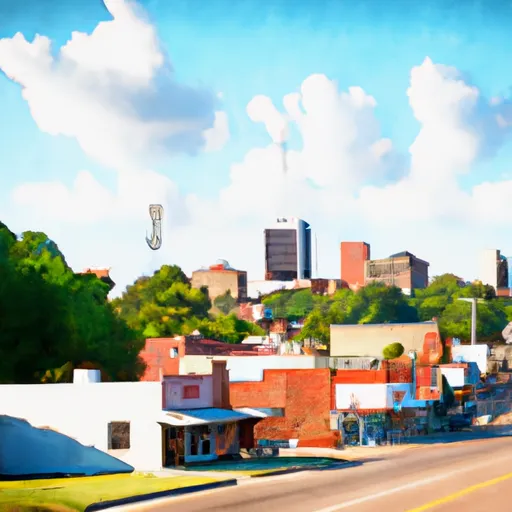-
 Snoflo Premium
Snoflo Premium
Get unlimited access to all our content
With no Ad interruptions! - Start Your Free Trial Login with existing account
Russell
Eden Index
Climate
8.0
•
Recreation
3.6
•
Community
•
Safeguard
4.4/10

Russell, Arkansas is a small town located in White County, in the central part of the state. The town experiences a humid subtropical climate characterized by hot, humid summers and mild winters. Summers are typically long and hot, with temperatures often exceeding 90°F (32°C), while winters are generally mild with temperatures averaging around 40°F (4°C). Precipitation is spread throughout the year, with slightly higher amounts during the summer months.
Russell is surrounded by several bodies of water, making it a great destination for water-based outdoor activities. The Little Red River flows just east of town, offering opportunities for fishing, boating, and kayaking. Greers Ferry Lake, located to the north, is a popular spot for water recreation, including swimming, jet skiing, and sailing. The lake is also known for its excellent fishing, with various species including bass, crappie, and catfish.
Additionally, Russell is surrounded by natural beauty, with several parks and wilderness areas nearby. The Bald Knob National Wildlife Refuge, located to the west, provides opportunities for birdwatching and hiking. The White River Wildlife Refuge, to the east, is another great spot for wildlife observation and photography.
In summary, Russell, Arkansas offers a pleasant climate with hot summers and mild winters. Its proximity to the Little Red River and Greers Ferry Lake provides ample opportunities for water-based outdoor recreation, while nearby wildlife refuges offer more options for nature enthusiasts.
What is the Eden Index?
The Snoflo Eden Index serves as a comprehensive rating system for regions, evaluating their desirability through a holistic assessment of climate health, outdoor recreation opportunities, and natural disaster risk, acknowledging the profound impact of these factors on livability and well-being.
Climate Health Indicator (CHI): 8.0
Russell receives approximately
1267mm of rain per year,
with humidity levels near 87%
and air temperatures averaging around
16°C.
Russell has a plant hardyness factor of
7, meaning
plants and agriculture in this region tend to thrive during the non-winter months.
By considering the ideal temperature range, reliable water supplies, clean air, and stable seasonal rain or snowpacks, the Climate Health Indicator (CHI) underscores the significance of a healthy climate as the foundation for quality living.
A healthy climate is paramount for ensuring a high quality of life and livability in a region, fostering both physical well-being and environmental harmony. This can be characterized by ideal temperatures, reliable access to water supplies, clean air, and consistent seasonal rain or snowpacks.
Weather Forecast
Streamflow Conditions
Upper White
Area Rivers
Upper White
Snowpack Depths
Upper White
Reservoir Storage Capacity
Upper White
Groundwater Levels
Recreational Opportunity Index (ROI): 3.6
The Recreational Opportunity Index (ROI) recognizes the value of outdoor recreational options, such as parks, hiking trails, camping sites, and fishing spots, while acknowledging that climate plays a pivotal role in ensuring the comfort and consistency of these experiences.
Access to outdoor recreational opportunities, encompassing activities such as parks, hiking, camping, and fishing, is crucial for overall well-being, and the climate plays a pivotal role in enabling and enhancing these experiences, ensuring that individuals can engage in nature-based activities comfortably and consistently.
Camping Areas
| Campground | Campsites | Reservations | Toilets | Showers | Elevation |
|---|---|---|---|---|---|
| Pendleton Bend | None | 172 ft | |||
| Kemper Williams Parish Park | None | 5 ft | |||
| Poverty Point Reservoir State Park | 50 | 97 ft | |||
| Graham Cave State Park | None | 778 ft | |||
| Notrebes Bend | None | 160 ft | |||
| Wilbur D Mills | None | 188 ft | |||
| Riverfront RV Park | None | 178 ft | |||
| Greer Crossing | 72 | 564 ft | |||
| Lake Fausse Pointe State Park | None | 5 ft | |||
| Oak Grove City Park | 30 | 117 ft |
Nearby Ski Areas
Catastrophe Safeguard Index (CSI):
The Catastrophe Safeguard Index (CSI) recognizes that natural disaster risk, encompassing floods, fires, hurricanes, and tornadoes, can drastically affect safety and the overall appeal of an area.
The level of natural disaster risk in a region significantly affects safety and the overall livability, with climate change amplifying these risks by potentially increasing the frequency and intensity of events like floods, fires, hurricanes, and tornadoes, thereby posing substantial challenges to community resilience and well-being.
Community Resilience Indicator (CRI):
The Community Resilience Indicator (CRI) recognizes that education, healthcare, and socioeconomics are crucial to the well-being of a region. The CRI acknowledges the profound impact of these elements on residents' overall quality of life. By evaluating educational resources, healthcare accessibility, and economic inclusivity, the index captures the essential aspects that contribute to a thriving community, fostering resident satisfaction, equity, and social cohesion.

